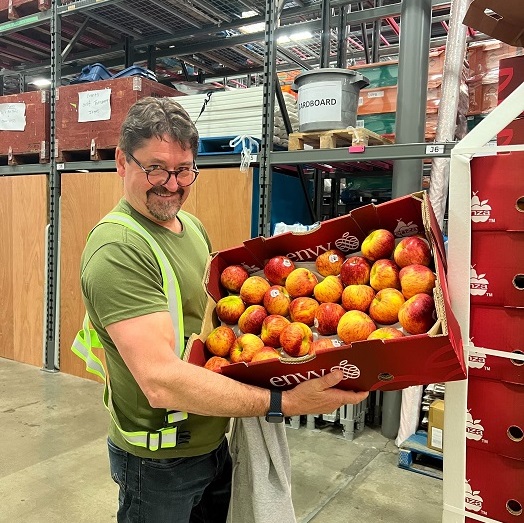Take a look at the food donation bin at your local grocery store. There's a sleeve or two of pasta in there. Some canned good and boxes of cookies. Maybe a full pack of granola bars. These non-perishable food items with a long shelf-life and no special storage requirements make them the go-to choice for donation. And while the cans and boxes are perfect for anyone needing pantry staples, the Greater Vancouver Food Bank's (GVFB) Chief Executive Officer David Long found a fresh new spin for those facing food insecurity. He just needed the space to store it al.
Veggies and dairy and fruit, oh my!

After an illustrious career cooking in kitchens around the world as a professional chef, David now wears the toque blanche at the GVFB, where he channels his passion for food by serving those in need in his community. Since his appointment in February 2019, together with his Chief Operating Officer, Cynthia Boulter, David has been finding innovative ways to provide more fresh, nutrient dense foods to GVFB's clients.
These days, their clients can expect to receive an assortment of fresh fruits and vegetables, proteins, and dairy products—the cost of which can be prohibitive for those on a limited budget. The shift towards fresh has had a positive impact on families in particular, who make up 30% of the GVFB's clientele. Beyond their nutritional benefits, increasing the accessibility of fresh and healthy foods has helped school-aged children focus better in the classroom, as a healthy diet is essential to both learning and development.
Keeping food fresh is essential to David's mission, so it came as no shock that he needed the proper facilities for storage—mainly refrigerators. GVFB's refrigerators had traditionally provided David with a perfect balance between supply and demand for their donations.
But all that changed when the GVFB saw a sudden influx of clients, unbalancing David's carefully curated system of nutrition.
Serving the community since 1983
The Greater Vancouver Food Bank (GVFB) was set up in 1983 to provide temporary relief during a hunger crisis. Thirty-nine years later, the GVFB continues to serve individuals and families throughout Burnaby, New Westminster, Vancouver and the North Shore. But this past year was unlike any other, with the COVID-19 pandemic and inflation driving up the number of new registrations. Undeterred, everyone—from employees and volunteers to donors and supporters—stepped up to the plate in a big way to distribute an astounding eight million pounds of food to those in need.
A different kind of space race

At the busiest distribution centre in Vancouver, volunteers used to serve 500–700 individuals and families every day. While these numbers are already high, they've increased dramatically with the onset of the pandemic and have continued to rise with inflation rates tightening the average family's budget for food. Over the last few months, David has reported that the GVFB sees around 1,000 new registrations each month, more than double what they recorded last year. "Over 60% of our clients reside in Vancouver," David says. "And we're seeing a record-breaking number of new clients seeking our support." And that number shows no sign of slowing down.
As the demand for fresh produce increased, David realized that they would need additional cold storage to ensure foods stayed safe for consumption. He needed an appropriate sized fridge installed, and that kind of addition didn't come cheap. Time wasn't on his side, either, as food could spoil before the team at GVFB managed to get it out to clients.
David wasn't deterred and knew there had to be a way to achieve his food donations dreams. All he and his team needed was a little bit of help. That's when he heard about a program at Agriculture and Agri-Food Canada (AAFC) that could possibly grant them a spacious, cold wish.
A cool delivery
The Local Food Infrastructure Fund
The Local Food Infrastructure Fund (LFIF) is a 5-year, $60 million initiative ending March 31, 2024. The LFIF is aimed at community-based, not-for-profit organizations with a mission to reduce food insecurity by establishing and strengthening their local food system. Since it was first launched in August 2019, $36.5 million has been committed to support over 821 growth-generating food security projects across Canada.
David was diligent in his research. While there were many programs available that suited his needs, AAFC's Local Food Infrastructure Fund was the perfect fit. He applied for a grant, and he and the staff at the GVFB were delighted when their application was accepted.
A few months later, David and his team welcomed a shiny new walk-in refrigerator and freezer at their downtown Vancouver distribution centre, increasing their cold storage capacity by 3,400 cubic feet. As David says: "The refrigeration has enabled us to distribute more fresh fruits, vegetables, and frozen proteins to our clients than ever before in Vancouver."
He didn't stop there, though. With his newfound cold storage expertize, David has helped purchase refrigerators and freezers in 26 other community-led organizations across the city using other funding initiatives. In return for his help, he only asks one thing: they allow the GVFB to stock them with fresh foods each week.
David's enthusiasm for putting fresh foods on the tables of individuals and families at GVFB goes beyond a job for him. It's a passion, one that drives him to explore and expand every day. Theirs is the kind of help that you don't often see lauded or showered with praise, but one that is invaluable to those who know the extent of their efforts. And for David and his team, this is just the beginning.
Get more Agri-info
- Want more stories like this? Explore what else Agri-info has to offer.
- Interested in reporting on this story? Contact AAFC Media Services at aafc.mediarelations-relationsmedias.aac@agr.gc.ca to arrange an interview with one of our experts.